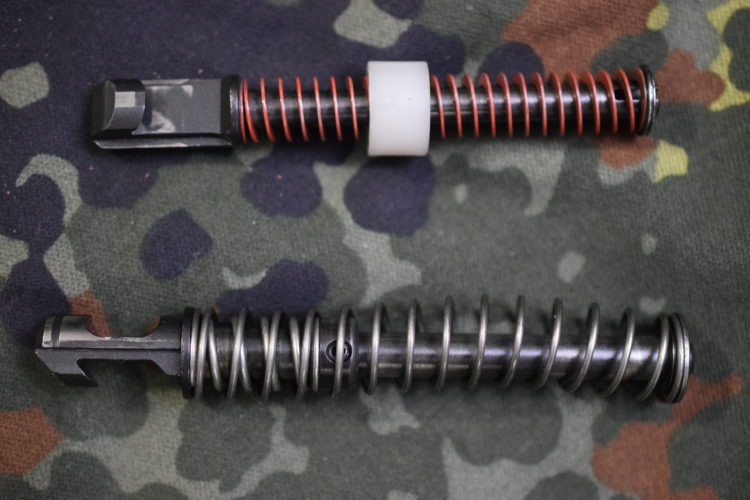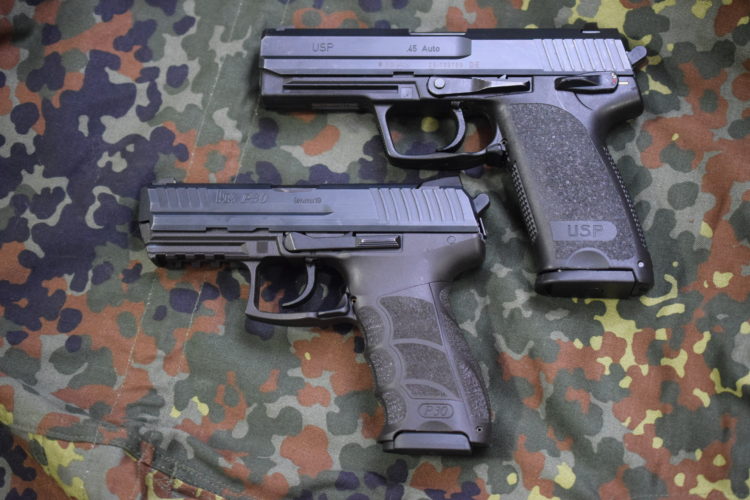There are few firearm manufacturers that carry the prestige and reputation for rugged reliability like H&K. The more recent development of the P30 took the market by storm with it’s updates to certain components and features based on feedback from Law Enforcement and Military units using previous models that preceded the P30.
NEW MARKET STANDARD
The introduction of the P30 to the market seemed to cause a huge change in the standards that were demanded by shooters. The enhanced ergonomics, in my view, was the original cause in the change of standards for the average consumer. Following the release of the P30, you started to see a big change in the ergonomics of other firearms designs. Manufacturers started to see that consumers were very much attracted to the concept of a very comfortable grip that was customizable to the individuals hand size. H&K has almost always led the way in market changing designs that the rest of the market is forced to follow in order to stay competitive.
HISTORY
Before the P30 was released, the P2000 was the most modern H&K design. Of course, the P2000 was basically an upgraded USP design that sought to answer the needs of LE and Military units that wanted an H&K pistol offering enhanced ergonomics, a smaller profile, and ambidextrous controls. I believe that H&K decided to use the USP Compact as a base for this upgrade and modernization since most of the contracts for H&K pistols were for the USP Compact. The P2000 answered alot of the needs for the departments and units out there, and I assume that H&K decided to then focus on upgrading the whole USP line to create a platform to cover all the needs out there. In my view, in looking at the design changes, the P30 is designed to replace the full sized USP by basically offering everything an individual could want. Enhanced ergonomics, ambidextrous and extended controls, wide range of variant options to include a long slide version are just some of the options made to appeal to potential buyers.
RELIABILITY
As far as the P30 reliability is concerned, Todd Green did a detailed test that showed the world the awesome capabilities of the platform in the hands of a competent individual. His 91,000 endurance test really showed how remarkably tough the design is. Todd Green was able to break many of his own personal records using the stock P30 during his many weeks testing the pistol. Not to take away from how well the pistol performs, but I feel that the design may have had a few compromises in order to answer the perceived needs of potential customers.
NO COMPROMISE?
I believe that one part of the USP may have been a good design to update and keep around. I believe that the original USP recoil reduction system that the full sized USP had would have been a better design for a pistol that perhaps is supposed to be a 21st century USP.

But unless there is another test that is done on the USP full size, there is no way to make a definitive conclusion on how much the original recoil reduction system would benefit the life of the pistol.
In my mind, H&K must have received alot of feedback on the longevity of both the compact and full sized models and decided the double spring system did not offer enough of an advantage to justify continuing the design. Perhaps this is the case, but I could definitely feel a difference in perceived recoil, in the USP and the P30, when using several different loads. Perhaps the shock on the frame is the focus instead of the felt recoil and the shooter comfort. Personally, I would think that H&K would keep a design that offered both comfort to the shooter and an overkill of cushion to the internals in order to stay true to their “No Compromise” motto.
Perhaps this perceived compromise and the limited service record is the reason most people still see the USP full size as the most durable design that really represents the H&K “No Compromise” motto. Obviously, it was the USP design that is to thank for the P30.
CRITICISM
After having a few P30 pistols, I have come to the conclusion that there are some issues that they created by departing from the USP design, or even the P2000 design. For instance, the sights on the P30 are novak style and do not offer a chance to manipulate the slide off a belt or other surface. The slide stops tend to be loose and have considerable wiggle, especially after a few hundred rounds. And for the size, I would think that H&K would try to give greater capacity to their pistols considering that 15 rounds in a full sized pistol is frowned upon these days. Also, the trigger on the P30 is not seen as being as refined in operation as the USP. The internals may be more robust, but the characteristics like the longer reset do not sit well with alot of the trigger snobs out there.
It would seem to me that the P30 is focused more on bringing quality into the ergonomics, aesthetics, and internal components, instead of giving quality to every detail like the sights, slide tops, etc. The USP in my mind is a much higher quality, and dare I say uncompromising, given the available technology, market requests, and manufacturing capabilities of the time of design. Obviously being modeled after the MK23, which was designed to be unbreakable, it can give the shooter the feeling of holding a pistol that has virtually no Kryptonite.
THE BIGGER PICTURE
I feel that the goal of the P30 is to replace the aging USP pistols with a more market-centered design that can still carry on the reliability demanded by the units and departments that use H&K to get the job done. Personally, beside the feelings and perceived compromises, I feel that the P30 would be a satisfactory pistol design to replace the USP. i do not think the P30 is good enough to say there is no place for the USP, but I feel that it may provide alot more options and flexibility to the end users.
Whether or not it is H&K’s decision to downgrade the quality of the pistol, it is on them to decide whether an overbuilt design is going to be the best option for sales in a market that is more centered on a reliable firearm that has the best aesthetics with custom “feel good in the hand” features. Though the P30 has seen little in ways of contracts, I feel that perhaps that will change in about 5 years when the USP becomes older and the users begin looking for a replacement design. Perhaps by that time, they will decide to stick with H&K and “upgrade” to the P30. We will just have to wait and see what happens, though.
*The views and opinions expressed on this website are solely those of the original authors and contributors. These views and opinions do not necessarily represent those of Spotter Up Magazine, the administrative staff, and/or any/all contributors to this site.


